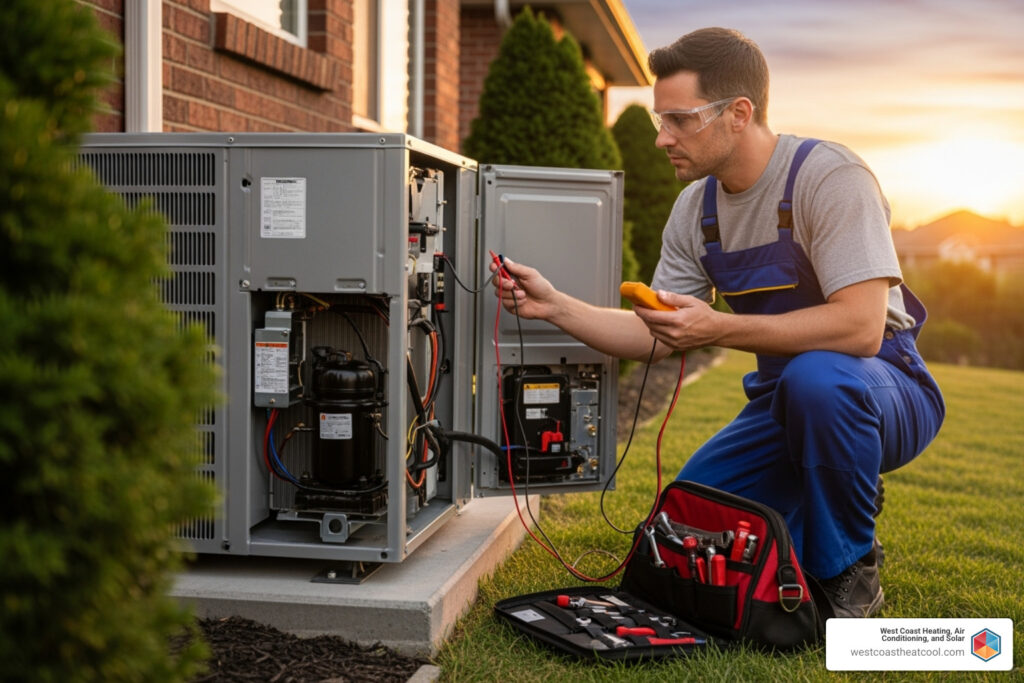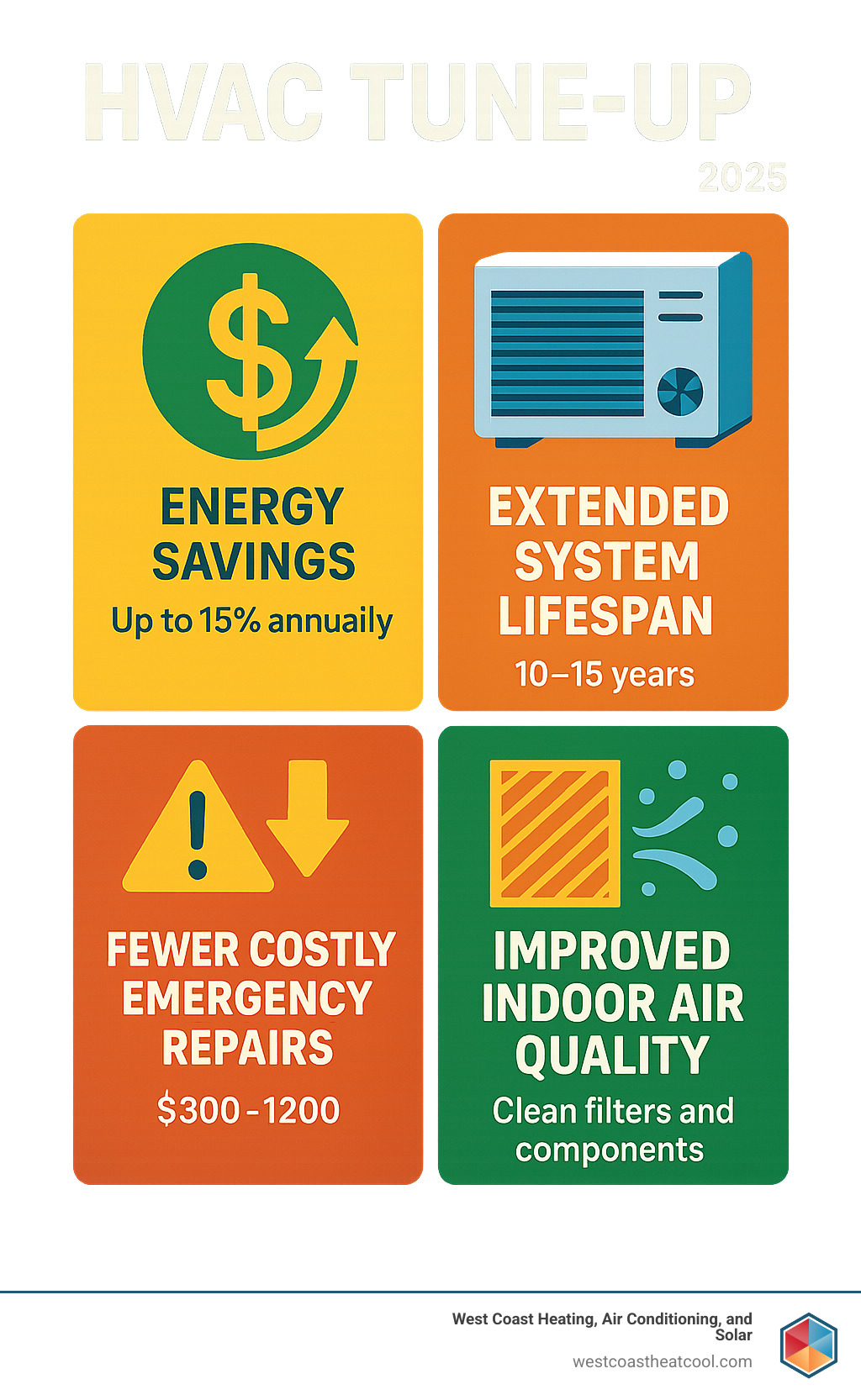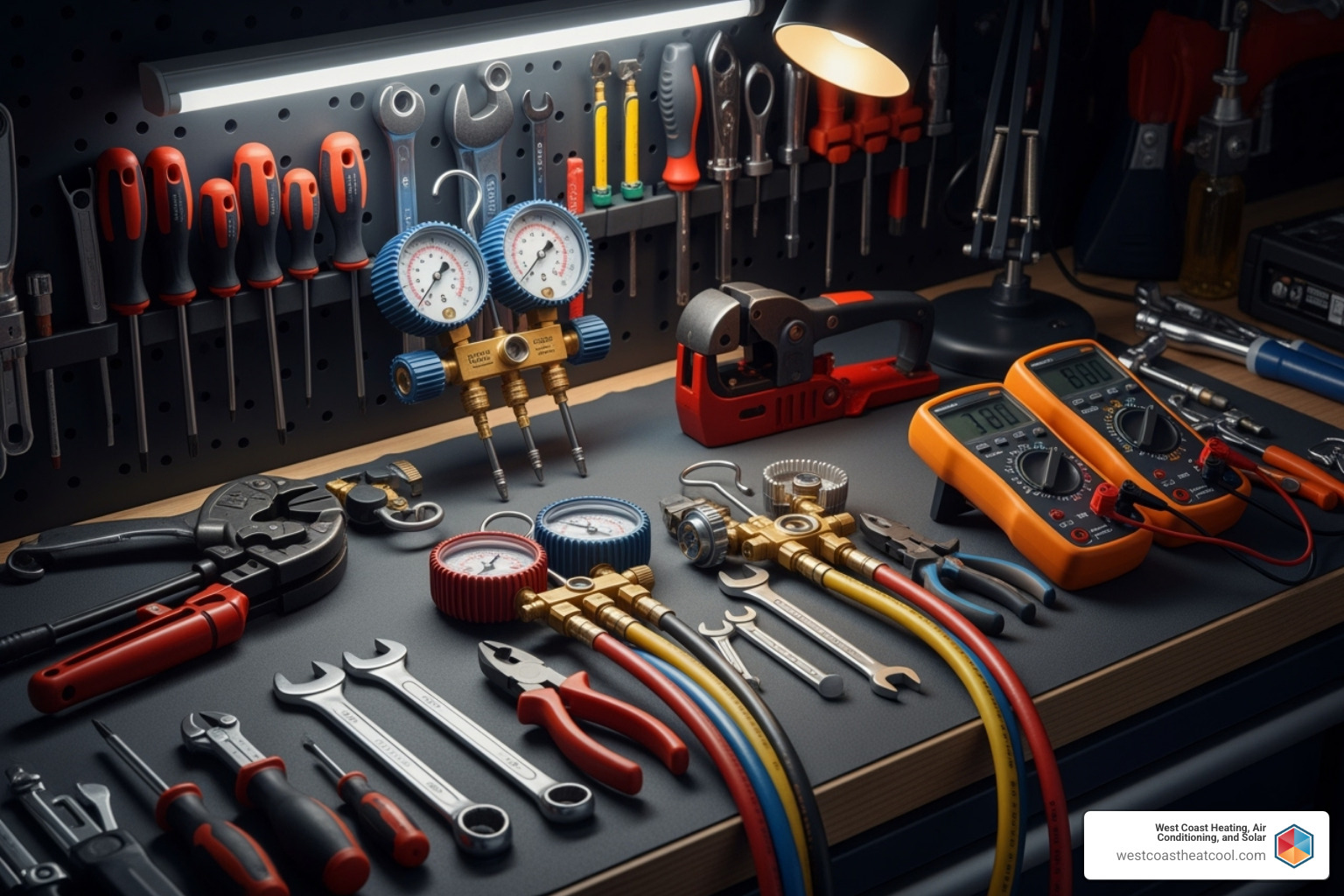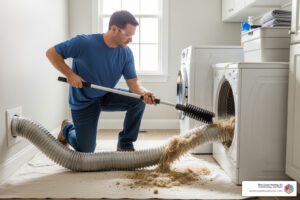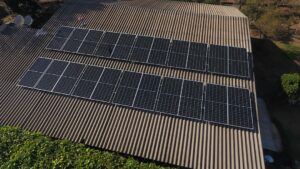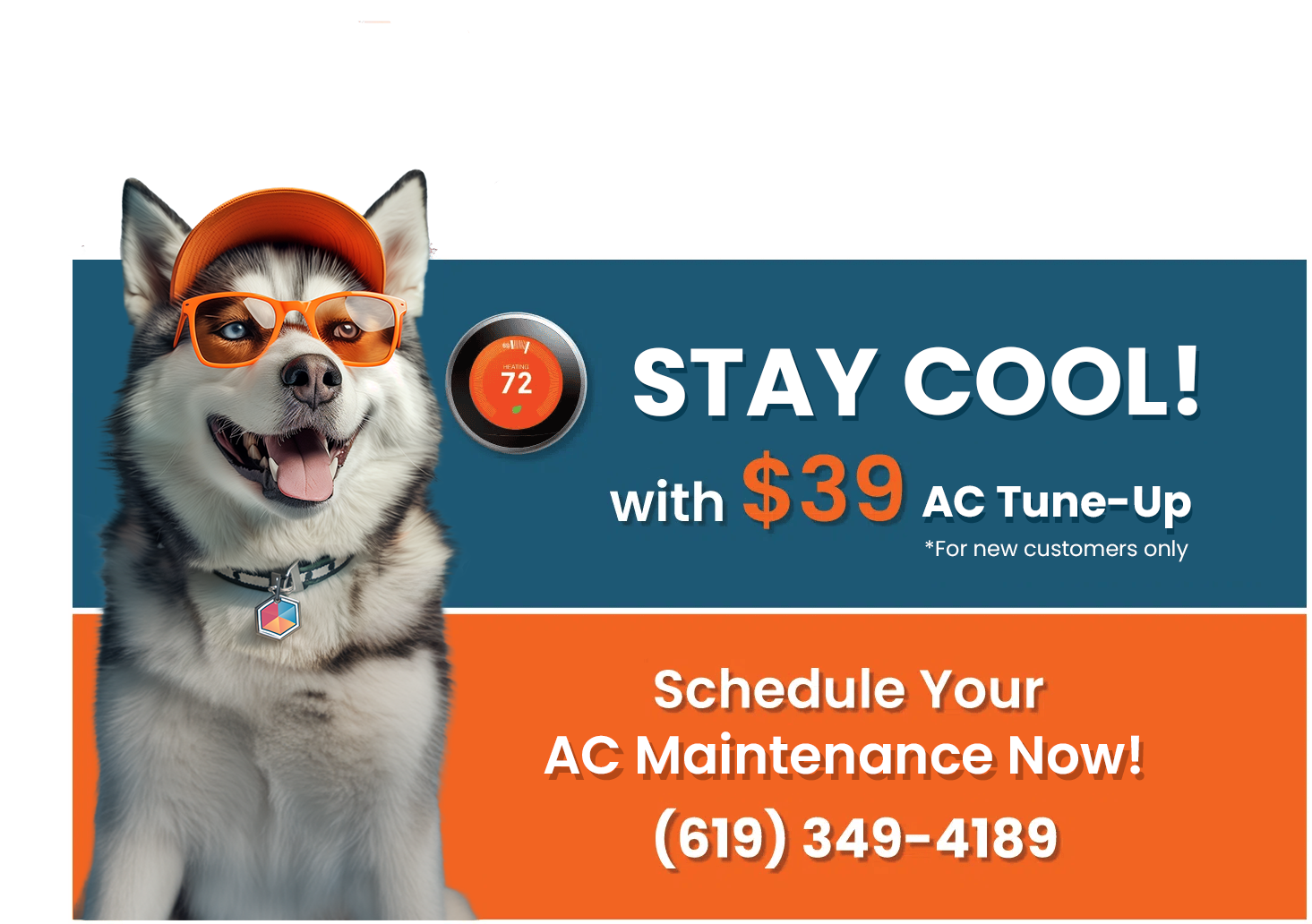Why Regular HVAC Maintenance Protects Your Home and Wallet
An HVAC tune up is a comprehensive preventative maintenance service performed by a certified technician to ensure your heating, ventilation, and air conditioning system operates efficiently, safely, and reliably.
Quick Answer – What’s Included in an HVAC Tune-Up:
- System Inspection: Check all major components for wear and damage
- Cleaning: Clean coils, blower components, and condensate drains
- Testing: Verify refrigerant levels, electrical connections, and safety controls
- Calibration: Adjust thermostat and system controls for optimal performance
- Filter Service: Replace or clean air filters
- Safety Checks: Inspect for gas leaks, electrical hazards, and carbon monoxide risks
Cost: Typically $75-$250 depending on system type
Duration: 1-1.5 hours for standard service
Frequency: Once per year minimum, twice yearly recommended for San Diego’s year-round climate
Think of it like getting an oil change for your car – except your HVAC system works every single day to keep your family comfortable. In San Diego County’s climate, where systems run nearly year-round, this maintenance becomes even more critical.
The data is compelling: regular tune-ups can save up to 15% on energy bills and extend your system’s lifespan up to 15 years. More importantly, they prevent those dreaded emergency breakdowns during heat waves when repair costs skyrocket and comfort disappears.
For San Diego homeowners dealing with rising utility costs and aging equipment, understanding what goes into professional maintenance – and when to schedule it – can mean the difference between manageable monthly bills and budget-busting repair emergencies.
The Big Payoff: How Regular Maintenance Saves You Money and Stress
Picture this: you’re relaxing in your perfectly cool San Diego home while your neighbor is frantically calling repair companies because their AC just died during a heat wave. What’s the difference? You scheduled that annual HVAC tune up.
Preventative maintenance is the most effective way to ensure your system runs efficiently and reliably, saving you from stress and unexpected costs. Here’s how:
- Lower Energy Bills: A well-maintained system runs more efficiently. The U.S. Department of Energy estimates that regular maintenance can save up to 15% on energy bills. For a typical San Diego household, that can mean hundreds of dollars back in your pocket each year.
- Extended Equipment Lifespan: An HVAC system is a major investment, typically lasting 10-15 years. With annual service, you can often extend that lifespan significantly, delaying a costly replacement of $4,000 to $12,000 or more.
- Fewer Costly Repairs: A tune-up, which typically costs between $75 and $250, allows technicians to spot and fix minor issues before they become major breakdowns. This helps you avoid emergency repair bills that can be two to three times higher, especially during peak season.
- Warranty Protection: Most manufacturer warranties require proof of annual maintenance. Skipping a tune-up could void your warranty, leaving you responsible for the full cost of repairs.
- Improved Comfort and Air Quality: A clean, well-calibrated system provides more consistent cooling and heating, eliminating hot spots. It also prevents the buildup of dust, mold, and allergens in your system, leading to healthier indoor air for your family.
Neglecting your system leads to the opposite: higher bills, poor air quality, frequent breakdowns (usually at the worst times), and a shorter equipment lifespan. An annual tune-up isn’t just a service—it’s an investment in your home’s comfort, safety, and financial well-being.
What’s Included in a Professional HVAC Tune-Up?
When we perform an HVAC tune up, we’re not just giving your system a quick once-over. It’s a comprehensive service designed to ensure every critical component is functioning optimally, safely, and efficiently. Think of it as a full physical for your home’s comfort system, performed by trained experts with specialized tools and knowledge.
Our West Coast Heating, Air Conditioning, and Solar technicians come equipped with everything needed to diagnose and optimize your system. Our process involves a detailed inspection, thorough cleaning, precise calibration, and essential safety checks. We put your air conditioner through its paces, checking its performance and identifying any potential issues before they become costly problems. It’s about more than just making sure your AC turns on; it’s about making sure it runs perfectly, protecting your investment and your comfort.
A Comprehensive Maintenance Checklist
We believe in transparency, so here’s a detailed look at what’s typically included in a standard HVAC tune up with our team:
-
Cooling System Checks:
- Clean condenser and evaporator coils: Dirty coils reduce efficiency and increase energy costs. We thoroughly clean them to restore peak performance.
- Check refrigerant levels: Incorrect refrigerant levels strain your system and reduce its lifespan. We check for the precise amount and identify potential leaks.
- Inspect condensate drain: A clogged drain can cause water damage and shut down your system. We ensure it’s clear and draining properly.
- Measure temperature differential: We measure the temperature drop across the indoor coil to verify your system is cooling effectively.
-
Heating System Checks (for furnaces):
- Inspect heat exchanger: This is a critical safety check. We inspect for cracks that could leak dangerous carbon monoxide into your home.
- Clean burner assembly: A dirty burner reduces efficiency and can be unsafe. We clean and adjust it for proper operation.
- Check gas pressure: We verify gas pressure to ensure safe and efficient combustion, preventing potential fire hazards.
- Test safety controls: We test all safety switches to ensure they will protect your home in case of a malfunction.
-
System-Wide Checks:
- Lubricate all moving parts: Proper lubrication reduces friction and wear on motors and fans, lowering electricity use.
- Tighten electrical connections: Loose connections are a fire hazard. We inspect and tighten all wiring and check motor voltage and current.
- Test thermostat calibration: We ensure your thermostat is accurate for optimal comfort and energy savings.
- Inspect blower components: We clean and adjust the blower motor and fan to ensure strong, consistent airflow throughout your home.
- Change air filter: A clean filter is essential for efficiency and air quality. We’ll replace or clean it and advise on the best schedule for your home.
- Inspect ductwork: We examine your ductwork for leaks or damage, which can cause significant energy loss and reduce comfort.
DIY vs. The Pros: What You Can Do and When to Call an Expert
We understand the desire to be a hands-on homeowner, and there are certainly some basic maintenance tasks you can perform yourself to keep your HVAC system running smoothly between professional tune-ups. However, when it comes to a full HVAC tune up, there’s a clear line where professional expertise becomes not just beneficial, but essential.
Homeowner maintenance is crucial for daily upkeep. Simple tasks like regularly changing your air filter or clearing debris from around your outdoor unit can make a big difference in efficiency and prevent minor issues.
But a professional tune-up involves complex systems that require specialized tools and training. Our technicians are certified by organizations like North American Technician Excellence (NATE), ensuring they have the expertise to handle your system safely. Attempting complex tasks yourself, especially those involving refrigerant or high-voltage electricity, can be dangerous and lead to costly damage.
Can I Perform My Own HVAC Tune-Up?
You can certainly perform some basic maintenance tasks yourself, and we encourage it! Here’s a quick comparison:
| DIY Tasks (Monthly) | Professional Tasks (Annually) |
|---|---|
| Change or clean air filters. | Check refrigerant levels and pressures. |
| Clear debris (leaves, twigs, dirt) from around the outdoor unit. | Clean internal components like the evaporator coil and blower wheel. |
| Keep supply and return vents clear of furniture and obstructions. | Inspect and tighten all electrical connections and test capacitors. |
| Visually inspect the outdoor unit for any obvious damage. | Inspect the furnace’s heat exchanger for cracks or damage. |
| Gently rinse the outdoor condenser coil with a garden hose. | Calibrate the thermostat and test system controls. |
Signs Your System is Crying Out for a Tune-Up
Even with regular filter changes, your system will eventually need professional attention. Call for a tune-up if you notice:
- Weak Airflow: Air isn’t coming out of the vents with the same force it used to.
- Strange Noises: Grinding, squealing, or clanking sounds are not normal.
- Unusual Smells: Musty or burning odors can indicate mold or electrical issues.
- Rising Energy Bills: A sudden, unexplained spike in your energy costs often points to an inefficient system.
- Frequent Cycling: The system turns on and off more frequently than usual.
- Inconsistent Temperatures: Some rooms are too hot while others are too cold.
The Big Payoff: How Regular Maintenance Saves You Money and Stress
Imagine a consistently comfortable home without surprise breakdowns or spiking utility bills. That peace of mind comes from a regular HVAC tune up. Proactive maintenance keeps your system efficient and reliable, often saving up to 15% on energy costs, extending equipment life, and avoiding emergency repairs.
Regular care also improves comfort and indoor air quality by ensuring clean components and correct airflow. Instead of reacting to problems in peak season, you prevent them—and protect your budget and your home.
The Real Cost of an HVAC Tune-Up and Why It’s Worth It
A typical tune-up runs $75–$250—a small, planned expense compared to urgent repairs or premature replacement ($4,000–$12,000+). It also helps keep manufacturer warranties valid, so you’re covered if a major component fails. In short: invest a little now to avoid big bills later.
Consequences of Neglect: What Happens When You Skip a Tune-Up
- Higher bills as dirt and wear force the system to work harder
- Poor indoor air quality from dusty or microbial buildup
- More frequent, costly breakdowns—often during heat waves
- Shortened equipment lifespan due to excess strain
- Potential safety risks (e.g., gas or electrical issues)
What’s Included in a Professional HVAC Tune-Up?
When we perform an HVAC tune up, we do far more than a quick check. It’s a targeted inspection, cleaning, calibration, and safety review designed to restore efficiency, reliability, and safe operation.
A Comprehensive Maintenance Checklist
-
Cooling System Checks:
- Clean condenser and evaporator coils to restore heat transfer and efficiency
- Verify refrigerant levels and check for leaks; record operating conditions
- Clear and test the condensate drain (and pump if present)
- Measure temperature differential to confirm proper cooling and airflow
-
Heating System Checks (for furnaces/heat pumps):
- Inspect heat exchanger for damage or cracks
- Clean and adjust the burner/ignition assembly
- Verify gas pressure and test safety controls
- Inspect flue/venting; confirm heat pump defrost and reversing valve operation
-
System-Wide Checks:
- Lubricate moving parts where applicable to reduce wear
- Tighten electrical connections; test capacitors, voltage, and current
- Calibrate thermostat; verify system start/stop and safety functions
- Clean/inspect blower assembly for proper airflow
- Replace or clean air filter; advise on type and change frequency
- Inspect ductwork for damage, leaks, or excessive static pressure
This streamlined process targets the components that most impact comfort, efficiency, and safety—so your system is ready for the season ahead.
DIY vs. The Pros: What You Can Do and When to Call an Expert
Basic homeowner care goes a long way—like changing filters and keeping the outdoor unit clear. But a full HVAC tune up involves refrigerant handling, high-voltage electrical testing, combustion safety checks, and specialized measurements that require training and professional tools. Attempting these tasks yourself can be unsafe and may damage your system.
Can I Perform My Own HVAC Tune-Up?
You can handle simple upkeep, while pros tackle the technical, safety-critical work.
| DIY Tasks (Monthly/Quarterly) | Professional Tasks (Annually) |
|---|---|
| Replace or clean air filters | Check refrigerant levels/pressures and diagnose leaks |
| Clear leaves/debris around the outdoor unit | Clean evaporator/condenser coils and blower components |
| Keep supply/return vents unblocked | Inspect/tighten electrical connections; test capacitors |
| Gently rinse the outdoor condenser coil | Inspect furnace heat exchanger and flue; verify gas pressure |
| Set thermostat schedules and verify basic operation | Calibrate thermostat; verify safety controls and overall system performance |
If you notice weak airflow, strange noises or smells, rising energy bills, or frequent cycling, schedule a professional tune-up to prevent bigger issues.

